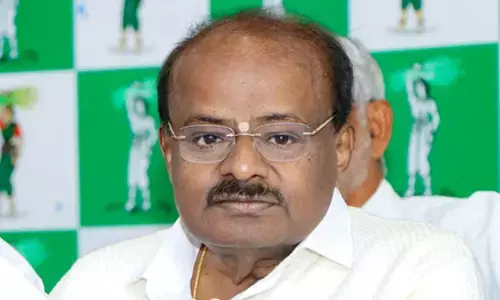DMRC's 20 years: Teacher-astrologer couple reminisces journey, daughter's birth

City-based teacher Geeta Kaushik is filled with pride and joy whenever she sees the Delhi Metro, for the state-of-the-art urban transporter and her daughter were born the same year -- 2002.
New Delhi: City-based teacher Geeta Kaushik is filled with pride and joy whenever she sees the Delhi Metro, for the state-of-the-art urban transporter and her daughter were born the same year -- 2002. Delhi Metro began operations on December 25 twenty years ago. A permanent exhibition has been opened at Welcome station on Red Line to mark two decades of its birth. Geeta Kaushik, 46, and her husband Ravi Kaushik, 53, an astrologer, both were ecstatic when they passed by the exhibition area.
"The old photo of the flagging off of the Delhi Metro train by Vajpayee ji, in presence of Sheila Dikshit that year immediately reminded us that it's Delhi Metro's birthday," Geeta Kaushik told PTI. "But for us, Delhi Metro and its eventful 20-year journey is even more joyful, as our daughter was born the same year. Every year, when I think of my daughter's birthday, I also immediately think of the birth of this amazing transport service too, which has served us for two decades and made our lives comfortable," she said.
"I never miss the Delhi Metro's anniversary." Kaushiks' daughter was born on October 4, barely two months before the start of the services, giving a chance to the couple to see their daughter and metro grow before their very eyes. "Just as Tushita took baby steps, and then walked, and ran, the Delhi Metro too took baby steps in 2002, and now has grown into a major urban transporter. It gives us double joy to see Delhi Metro grow," Geeta said.
Tushita, literally means 'satisfaction', the Kaushiks said, adding, Delhi Metro too has given its riders a lot of satisfaction. "My daughter is studying in a college right now, and also doing other academic courses from various institutions. We lay a lot of emphasis on good education," says the mother, who teaches art and English in a government-run school. The mascot of Delhi Metro is also a girl, says Ravi Kaushik with a smile, as he and his wife took a round of the exhibition that was opened on Saturday by Japan's Ambassador to India Hiroshi Suzuki in the presence of Delhi Metro Rail Corporation's Managing Director Vikas Kumar.
The exhibition has on display rare archival images and old news clips. It also showcases the partnership between Delhi Metro and Japan International Cooperation Agency (JICA) and other Japanese organisations which have supported Delhi Metro in its journey so far. Geeta Kaushik said the metro has definitely made the lives of women safer and more comfortable.
"When metro was being built in the late 90s, it was not very easy for us to travel from one part of the city to another. I am also an artist, and I was able to continue my hobby only because of metro as it allowed me to travel to Lodhi area from east Delhi with ease," she said. "I can travel alone in a metro too, and my daughter also feels safe and comfortable travelling alone, as there is a separate coach for women," she added. DMRC had a humble beginning with just an 8.2 km-long corridor connecting six stations on Red Line. Its train network has now grown over 390 kms spanning across Delhi and connecting some of the hard-to-reach parts of the city. To mark completion of its 20 years, the DMRC had on Saturday run a special train which was originally flagged off by Prime Minister Atal Bihari Vajpayee on December 24, 2002. Simran Sharma, who took a ride on that special train, concurred with Kaushiks and said Delhi Metro has made travel safe for women.
"Every train has a coach reserved for women, and there are some seats marked for women, as also for the elderly riders in other coaches, which is very good. More women are travelling because of the metro," she told PTI. Sharma said she travels for work between Krishna Nagar and Noida. Tanya Sharma, who works in a consultancy firm, said: "Metro journey is very convenient and I take it from east Delhi to my workplace in Gurgaon, and even on my off days to travel for leisure."
The DMRC's current network spans nearly 392 km with 286 stations (including the Noida Greater Noida Metro Corridor and Rapid Metro, Gurugram). Also, rare images of the very first piling work done in the national capital to build the Delhi Metro and old newspaper clippings are among the archival documents that have been displayed as part of a permanent exhibition -- 'Tracing Delhi Metro's Journey' -- that was opened December 2021 by the DMRC at Kashmere Gate station.















